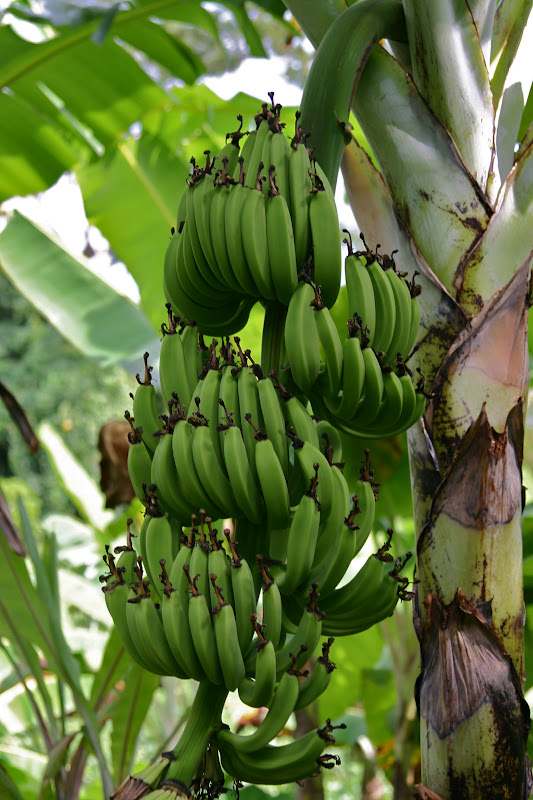So you just read about producers. The next organism in a food chain is the primary consumer. They get their energy from feeding on the producers and they are called herbivore or omnivores. Some examples of primary consumers in the rainforest are howler monkeys and three toed sloths, and the producer they eat are pine apples and bananas. So now you learned about primary consumers. So far in the food chain the sun gives energy to the producer, which gives energy to the primary consumers. What is next? Keep reading to find out!
Thursday, April 29, 2010
Rainforest Primary Consumers
So you just read about producers. The next organism in a food chain is the primary consumer. They get their energy from feeding on the producers and they are called herbivore or omnivores. Some examples of primary consumers in the rainforest are howler monkeys and three toed sloths, and the producer they eat are pine apples and bananas. So now you learned about primary consumers. So far in the food chain the sun gives energy to the producer, which gives energy to the primary consumers. What is next? Keep reading to find out!
Wednesday, April 28, 2010
Carbon Sinks,Sources,and Release agents
Carbon sinks are organic matter, or matter that has come from a recently living organism, limestone, shells, or even burial of organic material. One example is a redwood tree. They are carbon sinks because are they are long lived trees. Another example are plastic water bottles. One last example is a buried dog bone because the bone is organic matter, it's just buried in this situation. Carbon sinks can be dangerous because water bottles are bad for the environment unless they are disposed of properly because they take over 100 years to break down, and six pack soda holders can choke small marine animals. Carbon sources include respiration of living organisms such as people jumping rope, jogging, and running. Release agents are basically factories. One of them is a Lego factory. Others include human activities and forest fires. Human activities are cutting rainforests, which is bad, and forest fires are bad too.
Rainforest Producers
 The sun is the source of energy for all life on earth. The sun gives energy to producers, the first living thing of the food chain. Since we are focusing on a certain part of the earth, we will be focusing on certain producers in the rainforest. The sun gives energy to the producers which most of the time are plants like bananas, mangoes, and palm trees. All producers can produce their own food because they are plants, and they give life supporting oxygen and that's what makes this planet thrive. So I guess the conclusion we can draw from this is that the sun is the ultimate source of energy and I think the producers could've done something to avoid getting eaten by other things, but that's just life in the rainforest, because if nothing ate the producers, life will cease to thrive on this planet and we would see thin, malnourished bodies everywhere and... Am I scaring you? Anyway, to find out more about the things that eat producers, don't leave our blog just yet!
The sun is the source of energy for all life on earth. The sun gives energy to producers, the first living thing of the food chain. Since we are focusing on a certain part of the earth, we will be focusing on certain producers in the rainforest. The sun gives energy to the producers which most of the time are plants like bananas, mangoes, and palm trees. All producers can produce their own food because they are plants, and they give life supporting oxygen and that's what makes this planet thrive. So I guess the conclusion we can draw from this is that the sun is the ultimate source of energy and I think the producers could've done something to avoid getting eaten by other things, but that's just life in the rainforest, because if nothing ate the producers, life will cease to thrive on this planet and we would see thin, malnourished bodies everywhere and... Am I scaring you? Anyway, to find out more about the things that eat producers, don't leave our blog just yet!Monday, April 26, 2010
Tropical Rainforest Biome
Did you know that toucans eat bugs? No duh! Rain forests. Step into one and all you will see is lush green plants and exotic animals. But ever wonder about them? They have an average of 50 to 260 inches (125 to 660 cm) of rainfall every year. It has a very wet climate and it is vary humid(77% to 88%). The temperature ranges from 68 degrees Fahrenheit to 93 degrees Fahrenheit and all rain forests lie near the equator. But this is just simple info about these fascinating places to find out more read on.

Click on these links to watch a videos of endangered species:
http://www.youtube.com/watch?v=I-7wLdKjf2Y
http://www.youtube.com/watch?v=g4fRUwJNzB0&feature=related
Click on these links to watch a videos of endangered species:
http://www.youtube.com/watch?v=I-7wLdKjf2Y
http://www.youtube.com/watch?v=g4fRUwJNzB0&feature=related
Subscribe to:
Posts (Atom)